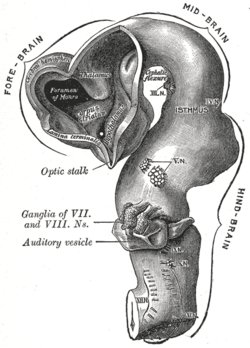Cephalic flexure
| Cephalic flexure | |
|---|---|
 Brain of human embryo of four and a half weeks, showing interior of fore-brain. (Cephalic flexure visible at center top.) | |
| Details | |
| Identifiers | |
| Latin | flexura mesencephalica |
| TE | E5.14.3.3.0.0.3 |
| Anatomical terminology | |
The mesencephalic flexure or cephalic flexure is the first flexure, or bend, of the embryonic brain; it appears in the region of the mid-brain. In human embryos it generally occurs at the end of the 3rd week/beginning of 4th.
By means of it the fore-brain is bent in a ventral direction around the anterior end of the notochord and fore-gut, with the result that the floor of the fore-brain comes to lie almost antiparallel with that of the hind-brain.
This flexure causes the mid-brain to become, for a time, the most prominent part of the brain, since its dorsal surface corresponds with the convexity of the curve. As a consequence, the cardiac plate, which was previously anterior to the forebrain, approximates its adult location in what will become the thoracic region.
References
This article incorporates text in the public domain from page 737 of the 20th edition of Gray's Anatomy (1918)